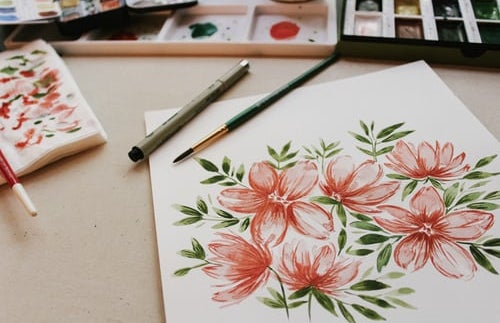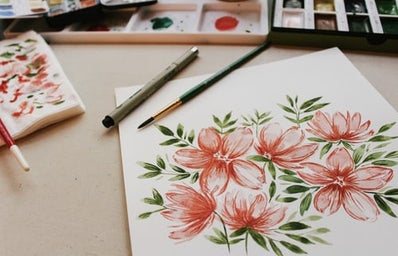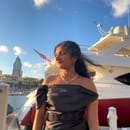It is difficult to start any new endeavor, but I believe the hardest one is art. Of course, art contains such a broad spectrum of practices, even ranging to include music and dance, but either way, it can be extremely challenging to know where to start, or even how to begin. As an artist, I work in a more traditional sense with graphite drawings and oil paintings, and recently I have been experimenting with digital art as well. Upon looking at some of the pieces I’ve made, it is sometimes hard for me to believe that I have taken no previous art classes and that I’ve picked up everything I know on my own. Although there was some degree of obligation in that I was making pieces for a required exhibition in high school, I still learned how to produce ideas and represent them artistically, as well as certain techniques specific to the medium itself. The process took a toll on me sometimes, as I would freeze up due to my inability to come up with a standardized method, but it taught me what I truly love doing and allowed me to work towards making a career out of my talents. Many people ask other artists how they got started and how they recommend others begin when they know nothing about art from the get-go. To this I say that no step-by-step plan will help anyone get to where they want to be, nor prescribe any advice that even you are unsure of. All I can do is show you where I got my footing as an artist, and only you will know where to go from there.
As a child, I never took my art seriously. I used to make doodles, little patterns like the henna designs I loved seeing in my culture, and sometimes drawings of cartoon characters I really adored. I remember being particularly fond of a sketch I did of Elsa after seeing Frozen when it first came out. I was amazed at my ability to match the linework of the reference so well, even as a 4th grader. I was so proud of my work that when I walked past a set of windows at school and saw another drawing of Elsa, I was almost overcome with jealousy and anger. How could this despicable 3rd grader challenge my artistic ability (she had no idea who I was)? Did she think she was better than me (she wasn’t)? That instance was the only time I felt so strongly about my art and my artistic ability. In any other capacity, I never took it seriously, at least not in the sense that I could make a career out of it (don’t ask why I was thinking about that in elementary school). In middle school, when we had the option to choose between band and art for our elective, I gravitated towards band. I don’t regret the time I spent there one bit, but back then all I could think of was that I was even more musically inclined than artistically talented. The only reason, now that I think about it, was because I never gave myself a chance with my art. I never focused on developing my style, making art, or refining the abilities that I always undermined. This may sound like regret, but what happened to me later in high school defined the rest of my artistic journey. So, I’m almost happy that I allowed myself to explore other options and interests in my childhood, paving the way for a more refined focus on my fruitful artistic endeavors.
High school was where my creativity really took off. I was a part of the IB (International Baccalaureate) Program, so the classes that I had to take were strictly focused on the core foundations of education: math, science, English, etc. Technically speaking, freshman and sophomore year should have been the year that I further explored my interests with more free space for electives, but I decided to take classes like creative writing, digital art imaging, and culinary instead (even though that was by accident). I won’t say it wasn’t fun to take those classes, but they didn’t spark any new wave of inspiration in me. I did find out that I had a knack for photography in my digital art imaging class, but it wasn’t something I felt I could fully lean into as a serious medium, just more of a hobby. In fact, this was the way I felt about pursuing any artistic endeavor as a career: it was only good as a hobby, nothing more. But that notion slowly started changing once I entered my junior year of high school, where it was truly time to start honing my interests into a feasible career.
When I was choosing my classes for the actual two years of the IB program, I asked my guidance counselor if I had to be any good at art to get through the HL Art program, and she told me that it didn’t matter at all. So, when I sat in the first official art class that I had ever taken on the first day of junior year, I was expecting to learn techniques, skills, or anything else that would allow me to explore various artistic mediums. What I was met with instead was a breakdown of what the IB Program expected in terms of projects and what our end goal was, the most intimidating being the 11-piece exhibition following a single theme that we would have to cultivate and put together throughout the entire two years of the course. Soon after that, I learned that I was entirely on my own, and making those pieces without the slightest inclination of an artistic process was going to be the biggest challenge I had ever faced – a challenge that I gladly accepted.
Luckily, my teacher had structured the course in a way that would allow me to explore my strengths and weaknesses first. For the very first semester, we made pieces focused on very specific aspects of composition, ranging from portraiture to mixed media. This was where I first explored oil painting, and I realized it was a medium that worked extremely well for me. For the very first piece of my exhibition, I decided to have a car in the background that appears to fly out of the darkness and into the frame. I remained true to the reference image I used in terms of composition while working within a somewhat monochromatic color scheme. This was where I discovered that I had a knack for copying the very essence of a reference while changing a few elements, and I was especially good at this with oil paint. This paint was a medium that blends very easily and dries very slowly, which allows the painter to take their time, an asset that was essential for a beginner like me. Without any specific artistic process, which is common for those who are versed in oil painting, I was able to understand what I was good at and what I found easiest. As I was able to explore other mediums due to the requirements of the program itself, I realized I enjoyed certain mediums over others, like oils and photography, and I also realized I was not able to make certain mediums work in the way that I intended, like watercolor. I had a very one-track mind; I didn’t allow myself to think of the numerous capabilities of the mediums and instead used them in their “intended” way, which isn’t the most flawed reasoning for someone who essentially has no idea what they are doing. But what helped me the most through the entire process was quantifying things in a way that made sense to me. If I wanted to capture a subject, I would visually break it down into parts and tackle them as such instead of taking on the entire image at once. Everything was split up into shapes that I could block out, and I avoided tracing purposely to test my limits and learn to sketch the subject freehand. Just because the subject didn’t look good with pure linework didn’t mean it was the end; shading and tonal value is what tied everything together. Little by little, piece by piece, I was figuring out the basics. But it was just that – the basics, the easy part. The hard part came when the pieces being made in class actually counted as contenders towards my final exhibition, and that was when I had to figure out my artistic style.
Well, thank God for Pinterest, right? It’s always good to have a goal, something to work towards, so you can at least set your mind on something. When I looked through a number of artworks, I took a mental note of what I found most appealing, and from that, I constructed my artistic standard. I found that I favored abstraction, but not in the sense that the subjects are completely unrecognizable. Realism wasn’t my style, but if I were to portray a scene of some sort (which is how I referred to compositions), I would want it to be seen through emotions, not just the way it is. I also thought it was fitting to challenge myself throughout the time I had to cultivate this exhibition, whether it be through an unfamiliar medium, a restrictive color palette, or a difficult subject. Now that I knew what I liked, what I was aiming for, and what I was in for, it was up to me to do the rest. I wouldn’t say I found the rest of the process easy, but it was definitely mind-opening. Challenging myself led me to a few dead ends, but it also gave me some nice results. What I found was that I had a knack for creative thinking; it wouldn’t take much for me to take inspiration from almost anything and make it into something. My interests were in narratives, and each and every one of my pieces had a story. Some were connected or even in the same universe, others stood on their own but were meaningful all the same. I know that sometimes it can be extremely difficult just to get started on something, and that is a phenomenon called “artist’s block.” But all I had to do was stop fearing the result, I just had to let myself go and give it a try. If anything, it helped me to know that the result wasn’t going to be anywhere near perfect, but if I took what I knew I was good at and made use of the things I learned along the way, then at least I would be further than where I began. The two years I spent creating pieces for the exhibition were probably the best years of my journey because that was when I figured out what I liked, where I wanted to be, and my process. And that is what has gotten me to where I am today.
I emphasized my fixation on a feasible career throughout my account because I believed that I would only make a career out of something I truly loved doing. I still hold that true today, and now I’m aiming to expand my artistic ability even further by pursuing graphic design. It may seem that a restrictive environment was what essentially forced me to come to terms with that, but that couldn’t be further from the truth. In reality, artistic processes are different for everyone, and finding one’s passion is also incredibly subjective. No matter the process, one must begin their journey knowing that mistakes will be made, but learning from them and trying something new is what gets a person further than where they began, even if it is little by little. It’s important to understand that what works for one person won’t always work for another, and what I discovered was that it was up to me alone to try. But no classroom or art class taught me the things that I love the most, and in a field like the arts, it’s up to the artist to figure out who they want to be.


